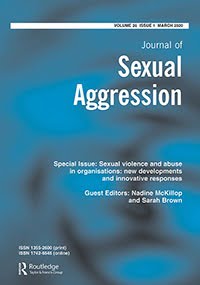Higher levels of porn use correlated positively with measures of:
- Likelihood to Rape
- Sexual Assault Perpetration
- Sexual Entitlement
- Hostility toward Women
————————————————
Amanda Goodson, Cortney A. Franklin & Leana A. Bouffard (2020), Journal of Sexual Aggression
DOI: 10.1080/13552600.2020.1733111
ABSTRACT
The etiology of the nexus between high-profile athletic participation and sexual aggression has been explained using Male Peer Support (MPS) Theory, though research is dated and has relied heavily upon college athletic participation. The present study assesses the relation between retrospective participation in high-profile, high school (HS) team sports and woman abuse using survey responses from a sample of 280 undergraduate men at a public university in the Pacific Northwest. Results from multivariate regression models indicate retrospective participation in high-profile, HS team sports was not a significant predictor of sexual aggression once other theoretical factors were accounted for in analyses. Endorsement of rape myths, increased encouragement from all-male peers for maladaptive behaviour, pornography consumption frequency, fraternity membership, and problematic alcohol consumption patterns predicted predatory sexual behaviour. Prevention programmes should target at-risk populations and all-male peer groups, specifically focusing on behaviours supportive of woman abuse.
Table with basic correlations. #8 is Pornography Consumption:

FROM DISCUSSION SECTION: (LR = likelihood to rape)
Next, results revealed the salient role of pornography consumption frequency as a significant predictor of LR, thus reiterating existing research on pornography consumption and rape proclivity, sexual coercion, and sexual aggression (Foubert, Brosi, & Bannon, 2011; Franklin et al., 2012; Malamuth, Addison, & Koss, 2000; Marshall, Miller, & Bouffard, 2017; Wright, Tokunaga, & Kraus, 2016) and providing some support for Schwarz and DeKeseredy’s MPS model. Mainstream heterosexual pornography has depicted the degradation of women, normalised violence, and objectified women, all of which contribute to unrealistic expectations about the way men may relate to women in interpersonal and intimacy contexts (Bridges, Wosnitzer, Scharrer, Sun, & Liberman, 2010; Sun, Bridges, Johnson, & Ezzell, 2016). Scholars have argued this has facilitated a range of violence against women (Mikorski & Szymanski, 2017; Salazar et al., 2018), though findings presented here suggest that men who more frequently consume pornography more readily expressed a desire to act out their sexual fantasies that involve coerced, intoxicated, or forced sex and sexual assault, but only if they were assured they would not be caught. This relationship did not appear in the model predicting sexual assault perpetration. There may be something about those men who express desire to rape as compared those men engage in sexual predation in terms of how pornography operates. Future research should continue to disentangle these important relations
